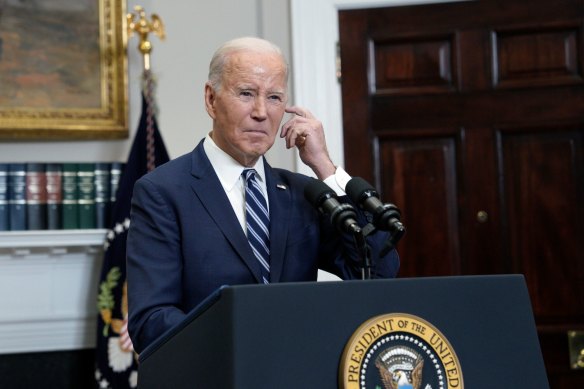
When this year started, the Fed was confident that interest rates would start falling this year, with a majority of the members of its Open Market Committee (which makes the rates decisions) expecting three rate cuts.
While the minutes of the March meeting of the committee shows they are sticking with that expectation, futures markets, which began the year factoring in as many as six rate reductions, are now pricing in only two. Some economists expect only one and others none.

Cost-of-living pressures are front of mind for US residents heading into this year’s presidential election. Credit: Bloomberg
Former US Treasury Secretary Larry Summers has even suggested that the federal funds rate (the equivalent of the Reserve Bank’s cash rate) might have to be increased.
“You have to take seriously the possibility that the next rate move will be upwards rather than downwards,” he told Bloomberg.
If the Fed were to cut rates three times this year it would probably have to start at either its June or July meeting (those in the markets seem to be anticipating a cut in July and then another at either the September or November meetings).
“On the current facts, a rate cut in June, it seems to me, would be a dangerous and egregious error comparable to the errors the Fed was making in the summer of 2021 (when it believed the spike in inflation was transitory and was slow to raise rates),” Summers said.
“We do not need rate cuts right now.”
The Fed and the markets have been blindsided by the shift in the trajectory of the inflation rate.
In the second half of last year the rate was falling steadily and faster than the Fed or markets had forecast. They expected that trend to continue into 2024, but progress has not just stalled but marginally reversed, with the US economy stronger than expected and creating a lot more jobs than expected.
As has been occurring elsewhere, housing-related costs have been a major influence on the stubbornness of the inflation rate. The recent surge in oil prices also isn’t helping.
In purely mathematical terms, progress this year after such a poor start will be made more difficult by the rate at which inflation subsided towards the end of last year, although the Fed will focus more on the month-to-month movements than the annual rate. It also tends to emphasise a different measure, personal consumption expenditures inflation, which has declined more than the CPI numbers might suggest.

Joe Biden’s re-election prospects have been dealt a heavy blow.Credit: Bloomberg.
Investors had hoped that the higher-than-expected inflation numbers for January and February were seasonally influenced aberrations. The March data contradicted that theory, which sparked a big sell-off in the sharemarket, with the S&P 500 down almost one per cent, and a big spike in bond yields.
The yield on two-year bonds jumped 23 basis points to 4.97 per cent while the yield on 10-year bonds rose 19 basis points to 4.55 per cent. Both securities are now generating their highest yields in five months.
The US sharemarket had been on a tear and is still up more than 8 per cent this year and more than 27 per cent higher than a year ago, with investors bullish about the outlook for interest rates. Price–earnings ratios for the S&P 500 are, at 25 times historical earnings, nearly 30 per cent above their long term average.
With rate cuts off the agenda until at least mid-year, investors will now have to rely on the continuing strength of the US economy and corporate earnings to justify the market’s current levels.
While an imminent rate cut looks increasingly unlikely, the Fed did foreshadow changes to the other policy tool it has employed to combat inflation, changes that might help the markets.
Loading
Since June 2022, the Fed has been allowing the $US4.7 trillion ($7.2 trillion) of bonds and mortgages it acquired to keep rates low and pump liquidity into the US economy during the pandemic to run off at a rate of up to $US95 billion a month. Its balance sheet has shrunk, and about $US1.5 trillion of liquidity has been withdrawn from the system as those securities have been allowed to mature without reinvestment of the proceeds.
The March minutes show that the Fed officials are now considering when and how to slow that process, known as quantitative tightening, with a majority “judging it prudent” to begin slowing the pace of the run-off fairly soon.
The Fed is wary about the potential for financial market stress as that policy reverses. In 2019, when the Fed started to unwind an earlier bout of quantitative tightening (of the securities bought in the aftermath of the 2008 financial crisis), the markets had conniptions because of liquidity stresses.
The Fed now wants a “smooth” transition from what it describes as the “abundant” reserves US banks now hold with it to its target of “ample” reserves. The Banks now have about $US3.5 trillion parked with the Fed.
There’s a balance involved. If the banks are holding too much of their liquid reserves with the Fed, it inhibits their lending; too few risks liquidity shortages in short-term finding markets and the kind of volatility and stress experienced in 2019, when those markets seized up.
A gradual easing of financial conditions as the Fed backs out of quantitative tightening – within a system where conditions are already quite accommodative – could provide some support for the economy as well as bond and sharemarkets.









 Add Category
Add Category